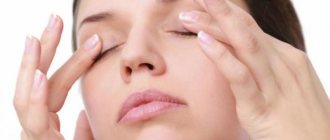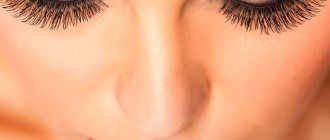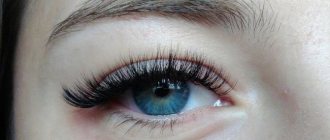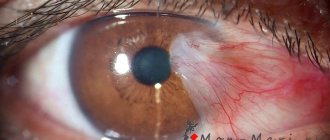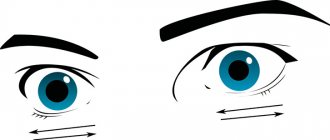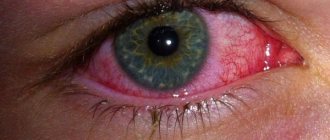If your eyes hurt from light, then the reason for this may lie in infectious diseases of the eyes, injuries and dry mucous membranes. This phenomenon can be caused by allergies or prolonged exposure to a dark room. The reason lies in irritation of the mucous membrane of the eyes, which leads to pain. A lack of tear fluid can also cause this problem. In this case, the membranes are poorly moisturized, which leads to severe irritation, with all the ensuing consequences. Let's take a closer look at all the reasons.
Causes of pain
Some people experience eye pain from sunlight or electric light. The photosensitivity of the retina increases, which occurs as a result of malfunctions in the body. The reasons for the appearance of this pathological phenomenon include:
- prolonged stay in front of a computer or TV;
- taking medications with an adverse reaction - photophobia;
- the result of radioactive exposure.
Also, the eyes hurt in the sun or in a room with bright artificial lighting and watery with the following pathologies and conditions:
- keratitis;
- acute or chronic conjunctivitis;
- iritis;
- myopia;
- glaucoma;
- direct look at the sun;
- bruise and eye injury;
- arterial hypertension;
- headache and migraine;
- reflection from white snow;
- a brain tumor;
- emotional stress;
- entry of a foreign body into the eye area;
- colds;
- encephalitis;
- VSD;
- trigeminal neuralgia;
- stroke;
- the natural aging process of the eye lens;
- albinism;
- brain abscess;
- head injury;
- lack of melanin or its absence;
- inflammation of the iris or cornea of the eye;
- toothache;
- incorrectly selected glasses;
- sinusitis.
Physiological causes of photophobia
Pain from bright light can occur for physiological reasons. The fact is that the organs of vision are designed for a certain load; if the norms are exceeded, this leads to irritation of the mucous membrane and pain. The following factors can provoke pain:
- Exit from a dark room into bright light.
- Working at the computer for a long time or watching TV for a long time.
- Looking at the sun or white snow.
- When seeing a bright light from welding.
- With mechanical irritation of the eyes, for example, with active rubbing with your hands.
In addition, if your eyes begin to hurt in bright light, this may be a natural reaction to a lack of melanin in the body.
In recent years, more and more people have complained of periodic photophobia. Many doctors associate this phenomenon with the use of smartphones.
You are healthy, but experience discomfort from bright light. What's the matter?
Office workers often complain of eye pain. This can be explained by the color scheme of the office interior, since some overly bright shades can become irritants for the retina of our eyes.
It is also necessary to take into account how dry the air in the room is, due, for example, to running air conditioning and other appliances, which is not very pleasant for sensitive eyes.
Sometimes eye pain can be caused by taking certain medications. For example, if you often take sedatives, anti-allergenic or anti-inflammatory substances, or medications for insomnia.
Remember that some of them, for example those containing ibuprofen, can cause irritation and increased dryness of the eyes. In this case, you should talk to your doctor about replacing it.
So, if your eyes react painfully to light, first determine why this is happening?
Go for a consultation with a doctor, he will help determine the cause and rule out the presence of serious diseases.
You may be interested in: How to choose the right glasses for working on a computer?
Main symptoms of sunstroke
Large loss of fluid and prolonged exposure to ultraviolet rays are harmful to humans. Overheating of the body can lead to sunstroke. Characteristic signs of this condition:
- headache, heaviness;
- rapid heartbeat;
- bloody discharge from the nose;
- body temperature rises above 38 degrees;
- loss of consciousness, loss of coordination;
- lethargy.
The victim experiences a sensation of temperature changes. During this condition, sweating is impaired and the skin becomes red. If the first measures taken to relieve symptoms have no effect and the headache continues, you should contact a medical facility.
Interesting: Dizzy and headache after chemotherapy: what to do?
Other signs
If, in addition to everything else, you are worried about frequent headaches, this is a reason to seek advice from a neurologist. Often the pain from bright light is accompanied by a headache. First, it can originate in the eye area and gradually spread to other parts of the head, or vice versa, it can begin, for example, in the back of the head and move to the eyes. If headaches bother you, this may be a sign of a neurological disease, in which case you need to contact a neurologist.
In addition to painful sensations, the following reaction of the body often occurs:
- pain in the eyes;
- blurred vision;
- frequent tears;
- weakness;
- nausea;
- dizziness.
Should I call an ambulance?
In some cases, symptoms of sunstroke appear after a person moves into a shady shelter or room. The severity of the condition must be determined by a doctor. If while in the sun you feel pain in the head, nausea and weakness, you should contact a medical institution.
Interesting: Why does your head hurt after you cry?
An increase in symptoms, increased pain and deterioration in well-being are a sign of a severe blow. To restore the body's functioning, anti-inflammatory and antipyretic drugs are used. In case of third degree of severity and disturbances of consciousness, resuscitation will be required.
My eyes hurt from the light and my head hurts
Eye pain and headache often accompany each other. The pain can “originate” first in the eye area and gradually move to the head, or it can arise somewhere in the back of the head and slowly spread to the organs of vision.
Doctors identify several diseases that cause these symptoms:
- Myopia (myopia) - severe tension in the eye muscles provokes a painful reaction of the nerves located in the head. Perhaps the diopters for your glasses were chosen incorrectly.
- Overfatigue - your eyes are constantly strained when you work for a long time at the computer, relax in front of the TV, or are mentally overstrained at work. This negatively affects the condition of the optic nerve, especially in a child who sits in front of a monitor for too long. The pain usually appears in both eyes in the afternoon.
- High blood pressure - eye pain with high blood pressure and visual disturbances, including light sensitivity.
- Head injuries - a sign of a concussion is headaches, which are reflected by pain in the eyes.
- Infectious lesion of the brain - pain is localized in the temples and eyes, moving to the occipital region. Additionally, dizziness, nausea, and weakness occur, which indicates symptoms of meningitis. The sooner you see a doctor, the lower the risk of death.
- Colds and flu are accompanied by pressing pain in the head and increased sensitivity to light.
- Migraine - occurs due to emotional and physical overload, weather changes, consumption of chocolate, cheese, nuts. The body begins to react in the form of throbbing pain in the temple area.
- Glaucoma - when the flow of fluid inside the eye is impaired, intraocular pressure increases. The disease is characterized not only by headache and eye pain. Patients often say: “I can’t look at the light, there’s something pressing on my eyes,” a colored halo appears around the light bulbs. If glaucoma is not diagnosed in time, the disease will lead to blindness.
In some cases, the eyes hurt from light and the head hurts due to a brain tumor, arteritis, Horton's syndrome, and trigeminal neuralgia.
Also, painful sensations in the eye and head area may indicate disturbances in the blood supply to the tissues around the eyes, when nutrients stop flowing to the visual organs due to vascular diseases. Pain in the eyes is sometimes provoked by disruptions of the vegetative-vascular system, sinusitis and sinusitis.
To determine the name of the disease, consult a specialist. The doctor will conduct the necessary diagnostics and prescribe appropriate treatment.
Causes
If the organ of vision regularly experiences overstrain, then the eyes may hurt in the light as part of dry eye syndrome - the eyes begin to water, turn red, and quickly get tired.
Photophobia due to inflammation of the mucous membrane and cornea is accompanied by redness, swelling, and pathological discharge.
Provoking factors that cause eyes to hurt in the light include:
- Overwork. Fatigue is caused by: prolonged exposure to a TV or computer screen, or wearing lenses for a long time.
- Excessive sunlight, artificial lighting from LED lamps.
- Migraine. Neurological headache is manifested by additional symptoms. Dizziness and nausea appear.
- Non-inflammatory ophthalmological diseases (glaucoma, cataracts, myopia).
- Inflammatory processes of the visual organ (keratitis, conjunctivitis, uveitis).
- Injuries to the visual organ and head.
- High blood pressure. The visual apparatus may hurt due to the effect of high blood pressure on the eye vessels.
- Albinism. The lack of melanin in the iris leads to increased sensitivity associated with bright lighting.
- Other diseases. During a cold, sinusitis, or toothache, the eyeballs may hurt again in intense lighting.
- Side effect of certain medications (“Furosemide”, “Quinine”). After discontinuation of the drug, the condition returns to normal.
- Radiation damage to the retina.
A child's eyes hurt in the light for the same reasons as adults. Often the symptom is caused by reasons related to the lighting of the computer and electronic gadgets, TV. Especially if the room is not lit and the screen emits bright light. After such entertainment, painful sensations appear in the eyes due to excess tension.
Watch a video with an ophthalmologist talking about photophobia:
What to do?
If your eyes hurt from daylight or artificial light and the pain does not go away within 3-4 days, you should not self-medicate, but consult a doctor. If the cause of the pain is an eye infection, such as conjunctivitis, improper self-treatment can lead to deterioration of the eye condition, sometimes even leading to loss of vision. The doctor will conduct the necessary diagnostic examinations and prescribe the correct therapy.
After making a diagnosis, a neurologist will prescribe medication and physiotherapeutic treatment.
Photophobia itself is a symptom of another disease. And to solve this problem, you need to know the cause of photophobia. The appearance of accompanying symptoms such as nausea, weakness and dizziness may indicate a serious neurological disease. In this case, it is necessary to consult with a neurologist who will prescribe medication and physiotherapeutic treatment, as well as eye exercises. In severe situations, surgery is used.
If an ophthalmological disease and its symptoms significantly worsen the quality of life, then the following methods can be used to diagnose the disease:
- Ultrasound;
- MRI;
- fundus examination;
- laboratory and clinical tests.
If the eyes are afraid of light and react painfully to it with myopia, the doctor will prescribe contact lenses or glasses and help you choose them. If an inflammatory eye disease is detected, the ophthalmologist prescribes eye drops and ointments, and for severe headaches and migraines, painkillers. Traditional medicine will help alleviate the condition. If the eye hurts, waters and cuts even with a weak light source, you should wear high-quality sunglasses throughout the entire treatment period.
Drugs
Your doctor may prescribe antibiotics in the form of tablets, injections, ointments, or drops. For ophthalmological ailments, when the eyes hurt in the sun and have difficulty seeing, the doctor may prescribe symptomatic treatment, including the following types of medications:
- anti-inflammatory drugs;
- anesthetics;
- antibiotics in the form of ointments, tablets, injections, drops;
- interferon-based drugs;
- solution for washing the eye area.
Folk remedies
To eliminate pain in the eyes from light, medicinal plants, for example, plantain, are used. To prepare the product you need the following ingredients:
- plantain - 20 g;
- boiling water - 300 ml.
Procedure:
- Pour boiling water over plantain in a thermos.
- Leave for 3 hours.
- Strain.
- Rinse eyes in the morning and evening.
Sea buckthorn compress
For a sea buckthorn compress, mix crushed berries with one teaspoon of honey. Ingredients:
- chopped fresh sea buckthorn pulp - 2 tablespoons;
- honey - 1 teaspoon.
Procedure:
- Mix sea buckthorn with honey.
- Apply compresses from the mixture for 7 days in the morning and evening for 15 minutes, evenly distributing 1 teaspoon of the product on cotton pads.
When you are bothered by a sore and cutting eye, these useful tips will help:
- If there is no fever, you can take a warm bath by adding chamomile infusion to the water. The pain should subside.
- To relieve pain, rub a raw potato onto a gauze cloth and apply it to your forehead.
- It is recommended to drink warm milk with honey, hot tea with lemon balm or chamomile. These drinks promote relaxation, as a result of which the pain will subside.
What to do to get rid of watery eyes
If it is known for sure that the cause of lacrimation is an allergy to the sun, then you will need to take a course of antihistamines. Effective ones include Ceterizine, Tavegil, Diazolin, Suprastin - 2-3 generation drugs that can cause side effects such as increased drowsiness and loss of concentration.
Doctors recommend using the latest generation of drugs to block histamines - Zyrtec, Claritin, Zodak: they do not have a negative effect on the nervous system and brain function.
As an additional measure, you can use “Artificial tear” eye drops, which moisturize the mucous membrane of the eyeball and help expand the tear ducts. They need to be used 3-5 times a day, placing 1-2 drops in each eye.
Ophthalmologists also recommend:
- eat more apricots - the pulp of the fruit contains lutein, which can soften the effect of sunlight on the retina;
- introduce carrot juice to the menu - this will strengthen the immune system and saturate the tissues of the visual organs with vitamin A;
- apply lotions made from decoctions of chamomile, linden flowers, mint leaves or black tea to the eyes several times a day.
We recommend reading the article about what to do if your nose is burned. From it you will learn what to do if your nose is burned, what not to do if you get a burn, when you need to see a doctor and preventive measures in the sun. And here is more information about how long it takes for redness to go away after sunbathing.
If your eyes water in the sun, you must first find out the true cause of this condition. If an allergy to ultraviolet rays is confirmed, it is enough to take a course of antihistamines - they will alleviate the condition after the first dose, but the best result will be after 2-3 days of using the drug. And then you need to exclude the irritating factor from the life of an allergy sufferer - wear special sunglasses, spend most of the time in the shade.
Treatment
If meningitis or encephalitis is diagnosed, then antibacterial or glucocorticoid therapy is mandatory. If any problems with the eyes are determined, eye drops are prescribed, and, if necessary, tablets or injections.
An effective remedy for restoring vision without surgery or doctors, recommended by our readers!
Often, when leaving a dark room on a sunny day, tears begin to flow from your eyes. I really want to close them with my hands. This is the weakest manifestation of photophobia. In more severe pathologies, pain, pain, and lacrimation occur at the slightest ray of light. Photophobia is one of the most common ophthalmological diseases.
Why do my eyes water on the street?
There are several reasons that can cause lacrimation when going outside:
- The most common and harmless reason for the appearance of tears from the eyes when the lighting changes and when there are gusts of wind is a natural protective reaction of the body. Tears moisturize the mucous membrane of the organ of vision from drying out and other possible damage. The body thus tries to correct the situation and fluid begins to be released from the eyes. There is no need to worry if the number of tears is insignificant and they stop after eliminating the irritating factor.
- When the problem of watery eyes on the street lies in incorrectly selected glasses for vision correction, you need to contact an ophthalmologist and tell him about your problem. Glasses should not cause a feeling of discomfort, and a person should see through them perfectly, without distorting the picture.
- The appearance of tears on the street can be caused by excessive eye strain. It happens that a person tries to peer closely at an object and concentrates his gaze on one place for a long time. If too much sunlight or gusts of wind are added to this, the result will be tears in your eyes. This way the eye will be protected from drying out.
- Your eyes may water on the street due to overwork. This phenomenon is often observed among drivers and people who work at the computer for a long time. Therefore, when going outside, additional stress occurs on the eyes and tears begin to flow from them.
- If a person wearing glasses has a similar problem on the street, then perhaps the reason for the release of tears lies in the fact that they were chosen incorrectly. While walking, the load on your eyesight increases and tears appear.
- Wearing lenses can cause excessive tearing on the street. In the case when they even slightly irritate the organ of vision, the eye will be under tension all the time. When other irritating factors appear, such as wind and sunlight, excessive lacrimation may occur.
- Your eyes may become watery on the street due to a foreign body getting into them. This could be street dust, sand, or debris. Sometimes it is not even possible to understand what caused the tearing. If it does not stop for a long time, even after washing the eyes, then it is necessary to visit an ophthalmologist for examination. The risk of a foreign body entering the organ of vision is especially high during strong winds.
- An allergic reaction, which is expressed in profuse lacrimation, itching and hyperemia of the eyelids and mucous membrane of the eye. Being in a room with closed windows, a person does not encounter large volumes of plant pollen. However, when he goes outside, she envelops him in an invisible cloud. This is why people suffering from seasonal allergies experience severe watery eyes even during a short walk.
- Sometimes the cause of excessive tearing on the street can be a cosmetic product containing some aggressive component. When a person leaves the room in windy or sunny weather, their eyes naturally become moisturized. Tears mix with cosmetics and begin to irritate the organ of vision, resulting in excessive lacrimation.
- Increased lacrimation under the influence of environmental factors can occur due to a lack of vitamins and nutrients in the body. The eyes are not able to function normally and quickly adapt to changing lighting, which is why such people cry profusely on the street.
- Conjunctivitis can cause increased production of tears on the street. This is especially noticeable in the initial stages of the development of the disease, even before discharge begins to appear from the eyes or irritation, pain, or itching occurs. Therefore, excessive production of tears on the street can be a sign of the onset of the disease.
- The cause of profuse lacrimation on the street can be rhinitis. This is due to the connection of the glands. When a runny nose worsens in windy and cool weather, the volume of tears produced increases. Therefore, diseases such as acute respiratory viral infections, tonsillitis, and influenza can provoke the appearance of tears on the street.
- Such a common dry eye syndrome may well provoke an increase in the volume of tears on the street. This is due to the fact that the organ of vision becomes more sensitive, including to wind and sunlight.
- Increased production of tears on the street is observed in older people. This is explained by the fact that their condition of the blood vessels of the eye and their muscles worsens. In addition, in old age, people often suffer from various eye diseases, which makes the organ of vision more sensitive and vulnerable to environmental factors.
- Sometimes the increased secretion of tears on the street can be explained by a spasm of the tubules through which it passes. In this case, the tear cannot enter the nasal slit, so it comes out when the slightest irritant appears in the form of wind or bright sunlight. Only an ophthalmologist can help in such a situation.
Why do my eyes water in winter?
If a person suffers from increased lacrimation outdoors in the warm season, then in winter he will almost certainly have a similar problem. To understand its causes, it is worth deciding on the factors that cause increased lacrimation in the cold.
Among them are the following:
- The body's natural defense reaction. A tear is formed in the eye in order to protect it from external factors, which in this case are frost and wind. Therefore, when leaving a warm room into the cold, the organ of vision is additionally moistened by the tear film.
- Allergy to cold or so-called Cold conjunctivitis is the body’s reaction to low environmental temperatures. Due to exposure to cold air, a person experiences a release of histamine, which leads to vasodilation, causes redness of the skin, swelling, and increases lacrimation. That is, all the signs of a normal allergic reaction are present, only the allergen in this case is frost. Moreover, women are more susceptible to this disease; the average age of onset of an allergic reaction is 30 years. In addition to watery eyes, a person may experience migraines and even asthma, but the most common symptom after exposure to cold is cold urticaria. It manifests itself in the form of itchy blisters in damaged areas.
- Eyes can also water in the cold due to the fact that a person spends a long time in a room with too dry air, the moisture from which will evaporate as a result of the central heating. As a result, all mucous membranes dry out - both the nasopharynx and the eyes. The organs of vision become more sensitive and when exposed to frost, they are abundantly moistened with tears.
The remaining causes of lacrimation when being outside in cold weather are similar to those that cause it in windy or sunny weather.
Preventive recommendations
If you are taking antihistamines, antibiotics, or blood pressure medications, you should wear sunglasses.
These medications help increase the sensitivity of the retina. You can’t sit in front of a computer or TV screen for a long time; you need to be in the fresh air more often and get a good night’s sleep. If the work involves welding, be sure to use a protective mask. If photophobia is caused by a cold or flu, it will go away after exposure to antipyretic medications.
Photophobia in children
In children, the appearance of sensitivity to light is due to the fact that the visual organs are not sufficiently developed. The symptom occurs in response to irritation from both natural light and artificial lighting. The child’s defense mechanism is triggered, he begins to blink quickly and squints. If this symptom persists for a long time and appears regularly over several days, this is a reason to see a pediatrician. In infants, the main causes of photophobia are:
- congenital photosensitivity;
- childhood infectious diseases - rubella, measles;
- aniridia – absence of the iris;
- cryptophthalmos – absence of eyelids;
- abnormalities of the eyeball - microphthalmos, anophthalmos;
- underdevelopment of eye structures - iris, cornea, lens, vitreous body;
- retinopathy of prematurity is a severe eye pathology with structural and functional changes in the retina and vitreous body.
In preschool children, photosensitivity manifests itself as a result of common inflammatory processes in the eye (conjunctivitis), which develop against the background of colds (acute respiratory infections, flu). Less commonly, when a foreign body gets into the eye.
Schoolchildren suffer from photophobia for the following reasons:
- systematic overstrain of the organ of vision;
- violation of the daily routine;
- constant lack of sleep at night;
- lack of physical activity according to age requirements;
- chronic fatigue;
- wearing contact lenses.
Symptoms in children directly depend on the causes. If a child has an acute inflammatory process, a childhood infection (measles), photosensitivity will be accompanied by an increase in body temperature and increased lacrimation.
In case of serious diseases (nerve paralysis, developmental anomalies), signs of photophobia are accompanied by the following manifestations:
- increased sweating;
- redness of the skin;
- drooping eyelid (ptosis);
- dilated pupil, does not respond to light stimulus.
The cause of photophobia in children can be not only diseases of a different nature, but also stress, lack of sleep or excessive fatigue. Children who spend a lot of time at the computer also often experience photophobia. The cause of this phenomenon may be prolonged treatment with antibiotics.
Photophobia among children and schoolchildren is not uncommon. The eyes become too sensitive, resulting in a burning sensation, increased blinking, and the child squints. If you notice these symptoms, they are permanent and you need medical help.
If your son or daughter complains of the presence of a foreign body with severe pain when exposed to light, check the thyroid gland. With bilateral damage, body temperature often rises.
If there is burning, itching, or lacrimation, we can talk about conjunctivitis - for the treatment to be effective, first conduct a comprehensive health examination.
It is important to correctly identify the cause of the problem and eliminate it - working with symptoms is useless. Parents should also ensure that the child spends moderate time at the computer, TV, gets enough rest, and gets enough sleep.
Walk enough time in the fresh air, keep your diet balanced. Eye gymnastics is useful for children.
Photophobia as a symptom of diseases
If photophobia is observed for a long time, it can be a symptom of various diseases. This symptom is accompanied by many ophthalmological diseases.
Migraine
Migraine is a chronic neurological disease. A distinctive feature of this disease is pain on one side of the head. The cause of attacks may be a violation of cerebral circulation, central nervous system disease, low or high blood pressure.
In people prone to migraines, an attack can be triggered by a change in weather, a stressful situation, being in a stuffy room, or overwork. Pain in the temple or eyebrow area can be triggered by noise, bright light and certain odors.
A contrast shower, a good night's sleep or a cup of warm tea will help to quickly stop an attack. Such people should try to rest more and lead a healthy lifestyle.
Glaucoma
Glaucoma is caused by increased intraocular pressure. This disease is accompanied by impaired visual fields and deterioration of visual function. A feature of glaucoma is a change in the color of the pupil, it becomes greenish or blue.
The disease can be triggered by a violation of the outflow of intraocular fluid. The cause of the disease can be infections and stressful situations. long-term use of hormones and ophthalmological diseases. All patients are at risk. over 50 years of age.
Does it hurt your eyes? Measures to prevent and relieve fatigue
High-quality and healthy sleep. As often as possible, you should perform simple preventive, relaxing exercises for the eyes, looking out the window and looking alternately at objects at close and far distances. It is important to take care in advance about the lighting of the workplace and the position of the computer screen. One of the main rules of good well-being during long and monotonous work - massaging the collar area and performing light kneading physical exercises. For the purpose of prevention, it is recommended to take courses of vitamins and dietary supplements in food. When swimming in the pool, you should wear special safety glasses to protect your eyes from pathogenic bacteria and chlorinated water. On sunny days it is preferable to wear glasses to prevent burns to the cornea of the eyes.
Allergic conjunctivitis and hay fever
Allergic conjunctivitis is another spring problem that literally develops before our eyes. The reason for this is hay fever, a reaction to pollen from plants blooming in spring. Allergic conjunctivitis is very easy to recognize. If, in addition to watery and itchy eyes, a person develops a runny nose (allergic rhinitis), breathing problems and a dry cough, as well as headaches, we are talking about this disease.
Symptoms of allergic conjunctivitis:
- Severe itching of the eyelids and burning under them.
- Tearing.
- Swelling and redness of the conjunctiva.
- Photophobia.
Considering that all these manifestations are combined with a runny nose, cough and various other forms of hay fever (laryngitis, tracheitis, etc.), spring becomes a nightmare for such patients.
The ideal option is to escape from the blooming source of your allergens to the other side of the Earth and return when it ends. But not everyone manages to do this. Then antihistamines and minimizing contact with pollen come to the rescue.
Symptoms of photophobia
It’s easy to identify signs of photosensitivity yourself. As soon as streams of bright light hit the retina, unpleasant sensations and discomfort appear in the orbit. A man tries to squint his eyes. Even dim light can cause irritation.
In parallel, a spasm of the eyelids is observed. Some people's pupils dilate. The eyeballs become pink or deep red. The person involuntarily begins to blink frequently. Complains of a feeling of sand in the eyes. Some people experience a temporary decrease in the quality of their vision.
Symptoms
It is known that in the sun, due to overheating of the body, the head hurts painfully. The patient also experiences:
- Increased sweating.
- Adynamia.
- Tachycardia.
- Head spinning.
- Nausea.
- Vomiting.
- Ear ringing.
- Loss of consciousness.
As soon as the first unpleasant symptoms of heat stroke appear, it is necessary to take all possible measures to stabilize the temperature in order to prevent the development of serious health problems.
